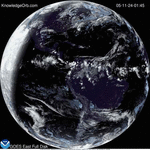The U.S. Presidential inauguration will get a special show Monday as the Moon and Jupiter will appear very close in the sky. The waxing gibbous phase moon, appearing 78 percent illuminated, will look to be a non-twinkling silvery “star.”
This will be closest that the moon and Jupiter will appear until the year 2026. The moon will be about of 248,700 miles (400,500 kilometers) from Earth, while Jupiter will be much farther out in space at a distance of 413.8 million miles (665.9 million km). The two will appear to be very close with Jupiter appearing just over the top of the Moon.
This event is what astronomers call an appulse — a very close approach of the moon to Jupiter. While appearing close they are actually very far apart and this event will have no effect on Earth. The width of moon is 0.5 of a degree. In the US and Canada, Jupiter will be separated from the moon by about 0.5 of a degree which is equivalent to the width of the moon. Visually, the planet will appear much closer such that there will be no gap between them.
Closest approach is at 11 p.m. EST. From the North Eastern U.S. Separation is 0.62 of a degree or one and a quarter times the apparent width of the moon from Jupiter. From Southeast U.S closest approach is at 11:02 p.m. EST, the separation is 0.33 of a degree or two-thirds of a moon’s width separating Jupiter from the moon’s upper edge.
If you use your Telescope Jupiter’s Great Red Spot can be visible in amateur telescopes from 9 p.m. to 10:40 p.m. EST (6 p.m. to 7:40 p.m. PST/0100 to 0240 GMT). While Jupiter’s moon Europa will cross in front of the planet, between 8:13 p.m. and 10:37 p.m. EST (5:13 p.m. and 7:37 p.m. PST/2213 and 2337 GMT).
Enjoy the show!








